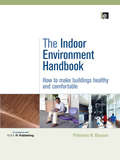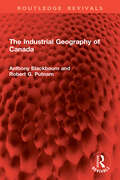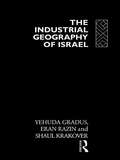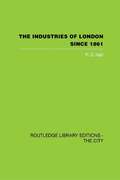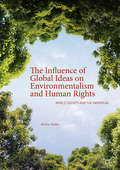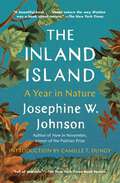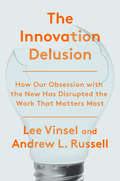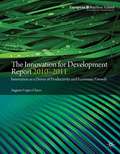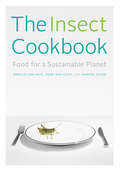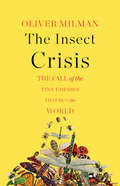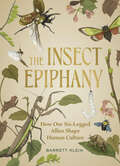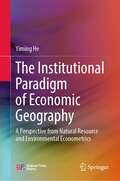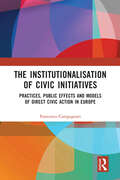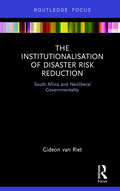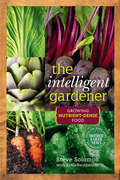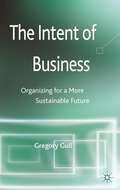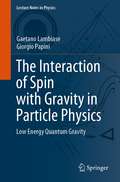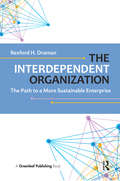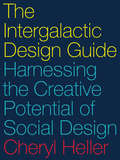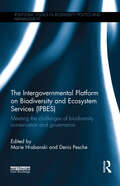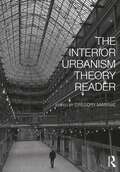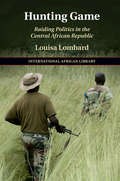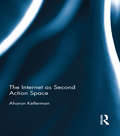- Table View
- List View
The Indoor Environment Handbook: How to Make Buildings Healthy and Comfortable
by Philomena BluyssenWinner of the Choice Outstanding Academic Titles of 2010 award. Ensuring that buildings are healthy and comfortable for their occupants is a primary concern of all architects and building engineers. This highly practical handbook will help make that process more efficient and effective. It begins with a guide to how the human body and senses react to different indoor environmental conditions, together with basic information on the parameters of the indoor environment and problems that can occur. It then moves on to give a background to the development of the study and control of the indoor environment, examining the main considerations (including thermal, lighting, indoor air and sound-related aspects) for a healthy and comfortable indoor environment and discussing the drivers for change in the field. The final section presents a new approach towards health and comfort in the indoor environment, where meeting the wishes and demands of the occupants with a holistic strategy becomes the over-riding priority. The book is filled with useful facts, figures and analysis, and practical methods that designers who are keen to assess and improve the user experience of their buildings will find invaluable.
The Industrial Geography of Canada (Routledge Revivals)
by Robert G. Putnam Anthony BlackbournFirst published in 1984, The Industrial Geography of Canada provides a comprehensive overview of the Canadian industry. It introduces Canada’s physical and human resources, describes the settlement pattern and charts the development of industry from 1945.The main characteristics of each province’s industry are outlined in detail: the poor remote Atlantic provinces, where attracting industry is a major problem; Quebec, where the distinct French-Canadian culture poses problems; the American domination of Ontario; the resource boom of Alberta; and the developing resource-based industries of British Columbia and the North. The book concludes with an examination of the prospects for successful national development goals in a country where regionalism is so strong.The Industrial Geography of Canada is a valuable text for all geographers with a particular interest in Canada.
The Industrial Geography of Israel
by Eran Razin Yehuda Gradus Shaul KrakoverIsrael's industrial geography is unique. The continuing Arab-Israeli conflict has been a primary force behind government intervention in settlement patterns, and has led to a major effort to disperse industry. The geopolitical situation has also encouraged a policy of attempted self-reliance, especially for defence purposes. These factors, combined with an abundant human capital, have given Israeli high-technology industries a special place in the international division of labour. The absorption of waves of mass immigration has influenced industrial development. Rural industrialisation, mainly by the Kibbutz (communal settlement) movement, is another unique feature. The Industrial Geography of Israel presents a comprehensive overview of industrial spatial development of Israel from the Ottoman era to present times, evaluating industrial dispersal policy, corporate geography, high-technology industries, entrepreneurship and rural industrial development. The spatial development of Israeli industry is set within the broader context of Israel's political and economic development and of global economic change, as well as theories of industrial location and regional planning and development.
The Industries of London Since 1861
by P.G. HallHall argues that 'London was the chief manufacturing centre of the country in 1861, and without doubt for centuries before that'. This book looks at industries in London over time from 1861. This book was first published in 1962.
The Influence of Global Ideas on Environmentalism and Human Rights
by Markus HadlerThis book explores whether individual attitudes and behaviors are swayed by global developments in a world increasingly populated by organizations, treaties, and other institutions that focus on environmentalism and human rights. It uses the sociological approach of World Society theory to investigate the effects of global ideas on individual environmentalism, xenophobia, and homophobia while drawing its data from a variety of international public opinion surveys. The Influence of Global Ideas on Environmentalism and Human Rights questions the dominant narrative of World Society related research as a positive influence of global ideas on various outcomes. Hadler demonstrates the complexity of this issue through empirical analyses revealing mixed trends in attitudes and behaviors from around the world. This book will be of interest to academics seeking to critically engage with World Society theory through two of its core topics: human rights and environmentalism.
The Informal Sector and the Environment (Routledge Studies in Ecological Economics)
by Ranjula Bali SwainThe informal economy – broadly defined as economic activity that is not subject to government regulation or taxation – sustains a large part of the world's workforce. It is a diverse, complex and growing area of activity. However, being largely unregulated, its impact on the environment has not been closely scrutinised or analysed. This edited volume demonstrates that the informal sector is a major source of environmental pollution and a major reason behind the environmental degradation accompanying the expansion of economic activity in developing countries. Environmental regulation and economic incentive policies are difficult to implement in this sector because economic units are unregistered, geographically dispersed and difficult to identify. Moreover, given their limited capital base, they cannot afford to pay pollution fees or install pollution abating equipment. Informal manufacturing units often operate under unscientific and unhealthy conditions, further contributing to polluting the environment. The book emphasizes and examines these challenges, and their solutions, encountered in various sectors of the informal economy, including urban waste pickers, small-scale farmers, informal workers, home-based workers, street vendors, and more. If the informal sector is to "Leave no one behind" (as the Sustainable Development Goals promise) and contribute to "inclusive growth" (an objective of the green economy), then its impact on the economy as well as the environment has to be carefully considered. This book marks a significant contribution to the literature on both the informal economy and sustainable development, and will be of great interest to readers in economics, geography, politics, environment studies and public policy more broadly.
The Inland Island: A Year in Nature
by Josephine Johnson&“A beautiful book...about nature the way Walden was a book about nature. It should be read by everyone who still retains the capacity to feel anything&” (The New York Times). Stunningly written and fiercely observed, a new edition of a classic work of nature writing about a year on an Ohio farm, by Pulitzer Prize–winning author Josephine Johnson.Originally published in 1969, The Inland Island is Josephine W. Johnson&’s startling and brilliant chronicle of nature and the seasons at her rambling thirty-seven-acre farm in Ohio, which she and her husband reverted to wilderness with the help of a state forester. Over the course of twelve months, she observes the changing landscape with a naturalist&’s precision and a poet&’s evocative language. Readers will marvel at the way she brings to life flashes of beauty, the inexorable cycle of growth and decay, and the creatures who live alongside her, great and small. A forerunner of iconic American women nature writers and a champion of civil rights who marched in Washington against the Vietnam war, Johnson intersperses these &“delicate marvels&” (The New York Times) with profound reflections about racial inequality, urbanization, social justice, and environmental destruction that speak powerfully to our time. Ready to be rediscovered by a new generation, The Inland Island is a vital and relevant meditation on nature and time, capturing the wonder, beauty, hope—and flaws—of our turbulent world.
The Innovation Delusion: How Our Obsession with the New Has Disrupted the Work That Matters Most
by Andrew L. Russell Lee VinselInnovation is the hottest buzzword in business. But what if our obsession with finding the next big thing has distracted us from the work that matters most?&“The most important book I&’ve read in a long time . . . It explains so much about what is wrong with our technology, our economy, and the world, and gives a simple recipe for how to fix it: Focus on understanding what it takes for your products and services to last.&”—Tim O&’Reilly, founder of O&’Reilly Media It&’s hard to avoid innovation these days. Nearly every product gets marketed as being disruptive, whether it&’s genuinely a new invention or just a new toothbrush. But in this manifesto on thestate of American work, historians of technology Lee Vinsel and Andrew L. Russell argue that our way of thinking about and pursuing innovation has made us poorer, less safe, and—ironically—less innovative. Drawing on years of original research and reporting, The Innovation Delusion shows how the ideology of change for its own sake has proved a disaster. Corporations have spent millions hiring chief innovation officers while their core businesses tank. Computer science programs have drilled their students on programming and design, even though theoverwhelming majority of jobs are in IT and maintenance. In countless cities, suburban sprawl has left local governments with loads of deferred repairs that they can&’t afford to fix. And sometimes innovation even kills—like in 2018 when a Miami bridge hailed for its innovative design collapsed onto a highway and killed six people. In this provocative, deeply researched book, Vinsel and Russell tell the story of how we devalued the work that underpins modern life—and, in doing so, wrecked our economy and public infrastructure while lining the pockets of consultants who combine the ego of Silicon Valley with the worst of Wall Street&’s greed. The authors offer a compelling plan for how we can shift our focus away from the pursuit of growth at all costs, and back toward neglected activities like maintenance, care, and upkeep. For anyone concerned by the crumbling state of our roads and bridges or the direction our economy is headed, The Innovation Delusion is a deeply necessary reevaluation of a trend we can still disrupt.
The Innovation for Development Report 2010–2011: Innovation as a Driver of Productivity and Economic Growth
by A. López-ClarosThis report provides a comprehensive look at the role of innovation in promoting economic and social development. It examines the impact of innovation on the economic growth of developing countries and the future role of technological innovation in international efforts to mitigate the effects of climate change, amongst many other issues.
The Insect Cookbook
by Marcel Dicke Françoise Takken-Kaminker Arnold Van Huis Henk Van Gurp Diane Blumenfeld-SchaapInsects will be appearing on our store shelves, menus, and plates within the decade. In The Insect Cookbook, two entomologists and a chef make the case for insects as a sustainable source of protein for humans and a necessary part of our future diet. They provide consumers and chefs with the essential facts about insects for culinary use, with recipes simple enough to make at home yet boasting the international flair of the world's most chic dishes.Insects are delicious and healthy. A large proportion of the world's population eats them as a delicacy. In Mexico, roasted ants are considered a treat, and the Japanese adore wasps. Insects not only are a tasty and versatile ingredient in the kitchen, but also are full of protein. Furthermore, insect farming is much more sustainable than meat production. The Insect Cookbook contains delicious recipes; interviews with top chefs, insect farmers, political figures, and nutrition experts (including chef René Redzepi, whose establishment was elected three times as "best restaurant of the world"; Kofi Annan, former secretary-general of the United Nations; and Daniella Martin of Girl Meets Bug); and all you want to know about cooking with insects, teaching twenty-first-century consumers where to buy insects, which ones are edible, and how to store and prepare them at home and in commercial spaces.
The Insect Cookbook: Food for a Sustainable Planet (Arts and Traditions of the Table: Perspectives on Culinary History)
by Marcel Dicke Arnold van Huis Henk van GurpThe Definitive Guide to Insects as a Sustainable Food SourceIn The Insect Cookbook, two entomologists and a chef make the case for insects as a sustainable source of protein for humans and a necessary part of our future diet. They provide consumers and chefs with the essential facts about insects for culinary use, with recipes simple enough to make at home yet boasting the international flair of the world's most chic dishes."Invite politicians to dinner and let them tell the world how delicious it is.... They will proudly go around and say, 'I ate crickets, I ate locusts, and they were delicious.'"—Kofi Annan The Insect Cookbook features delicious recipes and interviews with top chefs, insect farmers, political figures, and nutrition experts, including chef René Redzepi, whose establishment was elected three times as "best restaurant of the world"; Kofi Annan, former secretary-general of the United Nations; and Daniella Martin of Girl Meets Bug. The book contains all you need to know about cooking with insects, where to buy them, which ones are edible, and how to store and prepare them at home and in commercial spaces.
The Insect Crisis: The Fall of the Tiny Empires That Run the World
by Oliver MilmanA devastating examination of how collapsing insect populations worldwide threaten everything from wild birds to the food on our plate. From ants scurrying under leaf litter to bees able to fly higher than Mount Kilimanjaro, insects are everywhere. Three out of every four of our planet’s known animal species are insects. In The Insect Crisis, acclaimed journalist Oliver Milman dives into the torrent of recent evidence that suggests this kaleidoscopic group of creatures is suffering the greatest existential crisis in its remarkable 400-million-year history. What is causing the collapse of the insect world? Why does this alarming decline pose such a threat to us? And what can be done to stem the loss of the miniature empires that hold aloft life as we know it? With urgency and great clarity, Milman explores this hidden emergency, arguing that its consequences could even rival climate change. He joins the scientists tracking the decline of insect populations across the globe, including the soaring mountains of Mexico that host an epic, yet dwindling, migration of monarch butterflies; the verdant countryside of England that has been emptied of insect life; the gargantuan fields of U.S. agriculture that have proved a killing ground for bees; and an offbeat experiment in Denmark that shows there aren’t that many bugs splattering into your car windshield these days. These losses not only further tear at the tapestry of life on our degraded planet; they imperil everything we hold dear, from the food on our supermarket shelves to the medicines in our cabinets to the riot of nature that thrills and enlivens us. Even insects we may dread, including the hated cockroach, or the stinging wasp, play crucial ecological roles, and their decline would profoundly shape our own story. By connecting butterfly and bee, moth and beetle from across the globe, the full scope of loss renders a portrait of a crisis that threatens to upend the workings of our collective history. Part warning, part celebration of the incredible variety of insects, The Insect Crisis is a wake-up call for us all.
The Insect Epiphany: How Our Six-Legged Allies Shape Human Culture
by Barrett KleinFrom entomologist Barrett Klein comes a buzz-worthy exploration of the many ways insects have affected human society, history, and culture Insects surround us. They fuel life on Earth through their roles as pollinators, predators, and prey, but rarely do we consider the outsize influence they have had on our culture and civilization. Their anatomy and habits inform how we live, work, create art, and innovate. Featuring nearly 250 color images—from ancient etchings to avant-garde art, from bug-based meals to haute couture—The Insect Epiphany proves that our world would look very different without insects, not just because they are crucial to our ecosystems, but because they have shaped and inspired so many aspects of what makes us human.
The Institutional Paradigm of Economic Geography: A Perspective from Natural Resource and Environmental Econometrics
by Yiming HeThis groundbreaking book offers a comprehensive and contemporary analysis of the major areas of institutional economic geography. Each chapter discusses in detail the new developments and changes in the field, and with a balance of theory, applications and empirical tests provides a rigorous grounding in the economic analysis of the natural resources and environmental issues that are increasingly prominent policy concerns. The book is a must-read for any social scientist interested in real-world economic geography and institutional economics, including economists, political scientists, sociologists, historians, geographers and anthropologists.
The Institutionalisation of Civic Initiatives: Practices, Public Effects and Models of Direct Civic Action in Europe
by Francesco CampagnariThis book examines two civic initiatives in Europe and analyses their evolution through the institutionalisation of their practices, local public effects, and established models for action at broader scales.Drawing from the concepts of civic action, problematic situations, public problems, and experience, this book coins the concept of direct civic action to explore civic initiatives beyond sectorial categories. It draws from the histories, everyday activities, and encounters with new problematic situations of a Slovak and a French initiative. It analyses the institutionalisation of their internal practices, their public cultural services, the models for action they establish in broader networks of initiatives, and how institutionalisation affects their experimentation and innovation. This book uses two case studies of civic initiatives in France and Slovakia, examining how the experimental and institutionalised approaches to problematic situations of civic initiatives are associated with the generation and continuative reproduction of public goods and policies. It also explores how local initiatives establish national and international networks and models for direct civic action.This book is aimed at scholars interested in civic initiatives, urban planning, public policies, innovation studies, and urban sociology. It is intended to engage members of civic initiatives by offering insights into organisational dynamics and their impact on public issues. Furthermore, it appeals to public officials and policy-makers who aim to establish policies that promote civic initiatives and encourage direct civic action.
The Institutionalisation of Disaster Risk Reduction: South Africa and Neoliberal Governmentality (Routledge Studies in Hazards, Disaster Risk and Climate Change)
by Gideon van RietThe past three decades have seen a global shift in disaster management from an event driven response to a ‘could-be’ risk management approach. Disaster risk reduction (DRR) has become entrenched as a dominant paradigm within the field of disaster management. More than a decade after adopting DRR legislation in South Africa there remains a dearth of evidence that this has translated into substantive action. This book examines the institutionalisation of DRR in South Africa, conceived of as a political economy of knowledge production. Using a critical theory approach, the book does not consider why DRR is failing but instead asks ‘why DRR?’ As such, it explores possibilities beyond DRR’s narrow optic and offers new insights into disaster management through the lens of South Africa. This is valuable reading for graduate students and academics working in disaster studies, geography, public policy and development/post-development studies, as well as policy makers.
The Intelligent Gardener: Growing Nutrient-Dense Food (Mother Earth News Books for Wiser Living)
by Steve Solomon Erica Reinheimer&“It is bold, it is courageous, and it challenges many of our preconceptions about food, about soils, about farming, and about health.&” —Michael Ableman, farmer, author of Farm the City To grow produce of the highest nutritional quality, the essential minerals lacking in our soil from intensive agriculture must be replaced. The Intelligent Gardener is the practical, step-by-step guide for any serious gardener who wants to: · Demystify this process · Debunk much of the false and misleading information perpetuated by both the conventional and organic agricultural movements · Re-mineralize our soil. Accompanied with customizable web-based spreadsheets, this toolkit calls for far more attention to detail than the simple addition of composted manure or NPK fertilizers. It conclusively establishes the link between healthy soil, healthy food, and healthy people. Vegetables, fruits, and grains are a major source of vital nutrients, but centuries of intensive agriculture have depleted our soils to historic lows. As a result, the broccoli you consume today may have less than half the vitamins and minerals that the equivalent serving would have contained a hundred years ago. This is a matter of serious concern, since poor nutrition has been linked to myriad health problems including cancer, heart disease, obesity, high blood pressure, and diabetes. For optimum health we must increase the nutrient density of our foods to the levels enjoyed by previous generations. The Intelligent Gardener goes beyond organic—it offers the essential tools for those who care about the quality of the produce they grow. &“It&’s hard to imagine this book not having a significant and lasting impact on the way organic farmers and gardeners grow their crops.&” —Mark McDonald, West Coast Seeds
The Intent of Business
by Gregory GullInsights from varied disciplines such as: physics, mythology, psychology, philosophy, statistics, and systems theory to re-think the very intent of business and its corresponding organizing and management principles.
The Interaction of Spin with Gravity in Particle Physics: Low Energy Quantum Gravity (Lecture Notes in Physics #993)
by Gaetano Lambiase Giorgio PapiniThis book seeks to present a new way of thinking about the interaction of gravitational fields with quantum systems. Despite the massive amounts of research and experimentation, the myriad meetings, seminars and conferences, all of the articles, treatises and books, and the seemingly endless theorization, quantization and just plain speculation that have been engaged in regarding our evolving understanding of the quantum world, that world remains an enigma, even to the experts. The usefulness of general relativity in this regard has proven to be imperfect at best, but there is a new approach. We do not simply have to accept the limitations of Einstein's most celebrated theorem in regard to quantum theory; we can also embrace them, and thereby utilize them, to reveal new facts about the behavior of quantum systems within inertial and gravitational fields, and therefore about the very structure of space–time at the quantum level. By taking existing knowledge of the essential functionality of spin (along with the careful identification of the omnipresent inertial effects) and applying it to the quantum world, the book gives the reader a much clearer picture of the difference between the classical and quantum behaviors of a particle, shows that Einstein's ideas may not be as incompatible within this realm as many have come to believe, sparks new revelations of the way in which gravity affects quantum systems and brings a new level of efficiency—quantum efficiency, if you will—to the study of gravitational theory.
The Interdependent Organization: The Path to a More Sustainable Enterprise
by Rexford H. DramanThe Interdependent Organization provides its readers with a template for the development of an individualized transition plan to guide their journey toward becoming more organizationally sustainable. We as humans tend to rely on our current set of assumptions when we evaluate our actions and their potential impact on the future. With today’s ever-increasing rate of change in technology, our access to information, and cultural interactions (interdependence) around the world, the reliance on old ways of thinking (linear) will not allow us to effectively transition into the systems-based world of tomorrow. The Interdependent Organization presents a deeper understanding of the financial, operational, and cultural crossroads we are facing as a planet, and introduces a systems-based transitional path that individuals, organizations, and societies can draw on to move towards a more holistic and sustainable future. The book provides readers with the necessary understanding and insight into systems, systems-thinking, and the use of systems-based business tools to guide the sustainability journey while producing a positive impact to the organization’s bottom-line, its employee engagement, and its stakeholders’ expectations in each of the journey's three stages. The journey begins with the adoption of simple yet powerful systems-based tools for managing the organization’s operations and projects. These proven tools provide increased productivity with a proven bottom-line improvement that exceeds 30%. This introduction to systems-based tools and thinking provides the organization with the time to become more familiar with this new way of thinking and making business decisions before they expand their exposure to broader, more complex systems-based and sustainable practices. The second stage of this journey is focused on introducing new tools and practices to insure a consistent set of measures are used across the organization. The third and final stage focuses on aligning the organization’s people-management practices.
The Intergalactic Design Guide: Harnessing the Creative Potential of Social Design
by Cheryl HellerDesign has built global brands, disrupted industries, and transformed our lives with technology. It has also contributed to the complex challenges we face today. In The Intergalactic Design Guide, business strategist and designer Cheryl Heller shows how social design offers a new approach to navigate uncertainty, increase creativity, strengthen relationships, and develop our capacity to collaborate.The most innovative leaders in the world have instinctively practiced social design for decades. Heller has worked with many of these pioneers, observing patterns in their methods and translating them into an approach that can bring new creative energy to any organization. The Intergalactic Design Guide explains 11 common principles, a step-by-step process, and the essential skills for successful social design. Nine in-depth examples—from the CEO of the largest carpet manufacturer in the world to an entrepreneur with a passion for reducing food waste—illustrate the social design process in action.Whether you are launching a start-up or managing a global NGO, The Intergalactic Design Guide provides both inspiration and practical steps for designing a more resilient and fulfilling future.
The Intergovernmental Platform on Biodiversity and Ecosystem Services: Meeting the challenge of biodiversity conservation and governance (Routledge Studies in Biodiversity Politics and Management)
by Marie Hrabanski Denis PescheTwenty years after the Convention on Biological Diversity (CBD) entered into force, the founding of the Intergovernmental Platform on Biodiversity and Ecosystem Services (IPBES) in 2012 was the outcome of a long process of setting biodiversity issues at the top of the global environmental agenda. With contributions from more than a dozen well-renowned researchers in political science, law and sociology, this book analyzes IPBES functioning and challenges in terms of the knowledge selection process and actors involved. The book reveals that, through its conceptual framework, IPBES promotes a pluralistic view of nature that calls for a broadening of the disciplinary frontiers. It combines natural science and social science research and also includes indigenous and local knowledge. IPBES is considered to represent the institutionalization of a permanent knowledge assessment on biodiversity and is often referred to as an IPCC success story, constituting a new stage in global environmental governance. In analyzing the knowledge selection process for IPBES decision making, the book better situates IPBES within the biodiversity and global governance domain. It ultimately argues that the establishment of IPBES provides a new opportunity to coordinate the different international conventions (CBD, RAMSAR, CITES, etc.) and initiatives (international assessment of marine biology, scientific programs, funding, etc.).
The Interior Urbanism Theory Reader
by Gregory MarinicThe Interior Urbanism Theory Reader expands our understanding of urbanism, interiority, and publicness from a global perspective across time and cultures. From ancient origins to speculative futures, this book explores the rich complexities of interior urbanism as an interstitial socio-spatial condition. Employing an interdisciplinary lens, it examines the intersectional characteristics that define interior urbanism. Fifty chapters investigate the topic in relation to architecture, planning, urban design, interior architecture, interior design, archaeology, engineering, sociology, psychology, and geography. Individual essays reveal the historical, typological, and morphological origins of interior urbanism, as well as its diverse scales, occupancies, and atmospheres. The Interior Urbanism Theory Reader will appeal to scholars, practitioners, students, and enthusiasts of urbanism, architecture, planning, interiors, and the social sciences.
The International African Library: Raiding Politics In The Central African Republic (The\international African Library #61)
by Louisa LombardThe Internet as Second Action Space
by Aharon KellermanOne of the most significant and important advancements in information and communication technology over the past 20 years is the introduction and expansion of the Internet. Now almost universally available, the Internet brings us email, global voice and video communications, research repositories, reference libraries, and almost unlimited opportunities for daily activities. Bridging geographical distances in unprecedented ways, the Internet has impacted all aspects of our daily lives – from facilitating the running of businesses, the attainment of services and keeping in touch with friends and family. Accessible at any time and for many of us from our mobile phones, the Internet has opened up a world of knowledge and communication platforms that we cannot now imagine living without. This book explores the concept that the Internet has become a second action space for individuals. Coexisting with traditional and "obvious" real space, the Internet serves as a novel spatial platform and action space to its subscribers all over the world. Kellerman expertly discusses this notion and examines the practical integration of cyberspace with real space. Part I examines the Internet as a platform for action and presents its relations with physical space concerning a range of uses and applications which were traditionally performed in physical space only. It discusses the idea that the Internet has become a second space and explores theoretical perspectives surrounding this notion. The Internet has undeniably made humankind more efficient and connected. Part II explores the Internet as an action space for human life, considering basic human needs, curiosity, identity and social relations. It further considers instances whereby use and application of the Internet cannot be fully performed in real space, mainly regarding people’s presentation of identity. Part III explores daily actions over the Internet, such as work, shopping, banking and social interactions. Kellerman also briefly touches on the darker aspects that the expansion of the Internet has made possible – including its role in fraud and other crimes. The concluding chapter discusses people living across the two spaces and identifies potential future developments. The Internet as Second Actions Space will appeal to students across the social sciences, in particular those studying Geography, Sociology, Media Studies, Internet Studies, Business and related disciplines.
